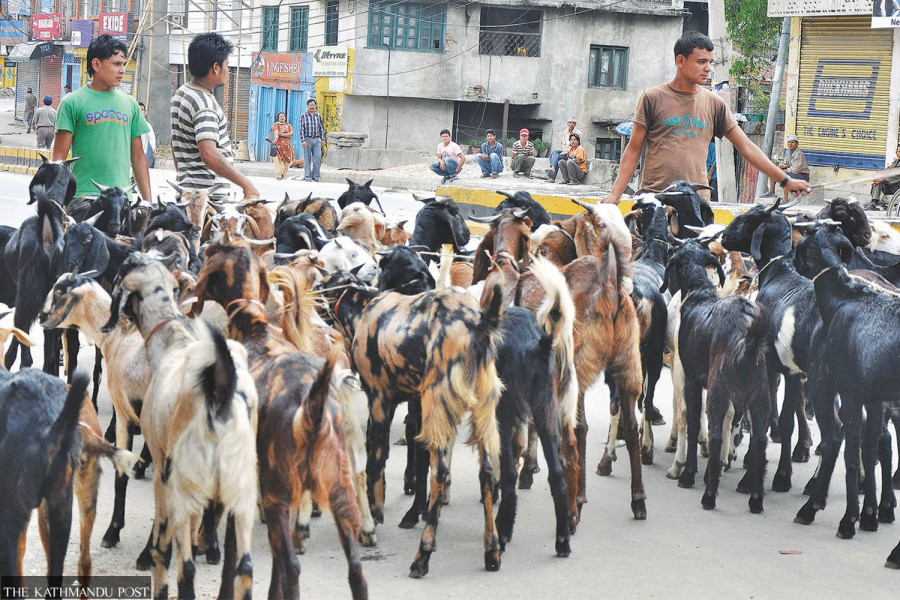Money
Traders hope Dashain goat demand may rise with economy on the mend
Demand for live goats in Kathmandu Valley estimated to exceed 70,000 heads this festival, on par with pre-Covid period.
Post Report
The livestock sector was hit hard by rising feed prices and the contraction of meat consumption last Dashain.
This year too, an economic depression and growing joblessness have resulted in a fall in urban household incomes, subduing meat demand. This has affected rural farmers.
Lately, however, traders are optimistic about Dashain as they see signs of an economic revival. The 10-day festival begins on October 3.
The Kathmandu valley is estimated to have consumed 50,000 to 55,000 goats last Dashain.
They estimate the demand in the Valley to surpass 70,000 heads this year, equal to the pre-Covid period.
“Nearly 45,000 live goats will be brought by traders at the Kalanki goat market this year,” said Janak Kumar Khadka, president of the Kalanki Khasi Bazaar, one of the oldest livestock markets in Kathmandu.
Farmers from different districts also supply goats to Kathmandu, which are estimated to be around 25,000 heads.
“We will put extra stalls for farmers who come to sell goats on their own in the market,” said Khadka.
The financial situation of farmers has worsened because of an increase in expenditure resulting from a rise in operating costs. Another factor is the slump in the consumption of meat and dairy products. Dairy farmers have not been paid by private and state-owned dairies for months.
Economists say consumption has slowed down because people's real incomes have dwindled while urban households' finances are tightened due to growing unemployment, a decrease in real estate and stock prices, and rising cases of fraud in the cooperatives sector.
The economic slowdown dampened the festival spirit last year, but traders are quite optimistic this year.
While there is no official data on festival spending, economic activity in Nepal peaks during September-November.
Some economists estimate that 40 to 70 percent of market activities occur around the three key festivals of Dashain, Tihar and Chhath.
It is estimated that many people save throughout the year to spend during these festivals.
Business house, bank, and government workers receive bonuses for festivals, and suppliers are keen to capitalise on the increased demand.
Last Dashain, the cash crunch forced consumers to cut back on purchases. But this year, banks have sufficient liquidity, and traders are optimistic about sales growth.
Traders say that the price of goats, which has already shot up due to the cost of production, will remain stable this Dashain.
Animal sacrifices and feast mark the festival, with tens of thousands of animals and birds slaughtered during the country’s biggest festival.
Khadka said that as domestic production would be sufficient to meet the Valley's requirements, there would be no imports. “Due to the normal supply trend, prices may remain unchanged at the current market rate.”
Live goat prices range from Rs660 to Rs670 per kg in the market.
Last Dashain, the price of live goats weighing 20-25 kg was Rs560 per kg, while goats weighing above 25 kg sold for Rs570 a kg.
Every Dashain, the Food Management and Trading Company sells goats and mountain goats to check prices that tend to go up on the pretext of festivals.
This year, it plans to bring in 1,800 goats and mountain goats.
“We have allocated around Rs40 million to buy goats,” said Sharmila Neupane Subedi, information officer at the Food Management and Trading Company. “The budget has been managed from internal sources.”
According to the company, goats and mountain goats will arrive at the company’s office on October 3, the day of Ghatasthapana. Goats are mainly supplied from Hetauda and Dang, and mountain goats from Mustang.
The animals will be sold from four company outlets in the Valley. The state-run company will also fix the price of goats on Ghatasthapana.
“Even though market prices fluctuate, we will set it based on the buying rate,” Subedi said. “But observing the market, I do not think the price will increase.”
The company plans to reduce the number of animals, as some died last year for the lack of proper management.
Last year, the company supplied 1,659 goats and 542 mountain goats for Dashain. Subedi said around 42 goats died as the livestock was kept in unfavourable weather conditions for long.
Most of the goat and mountain goat sales happen on the seventh, eighth and ninth days of Dashain.
This year, as the ninth day of Dashain overlaps the eighth, traders said sales will pick up from the seventh day.




 7.12°C Kathmandu
7.12°C Kathmandu












%20(1).jpg&w=300&height=200)
